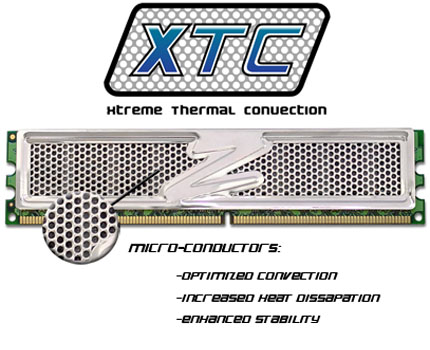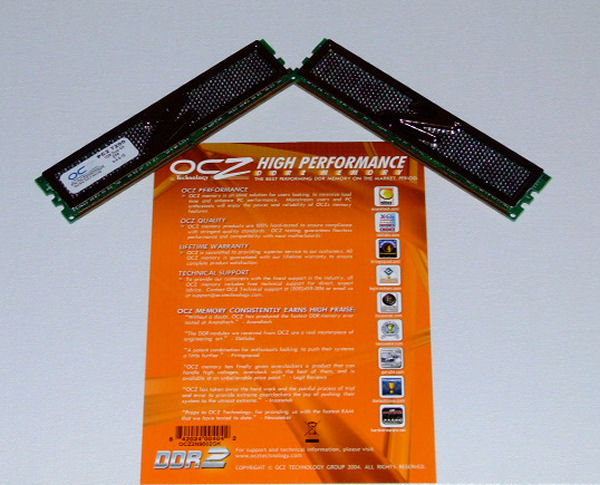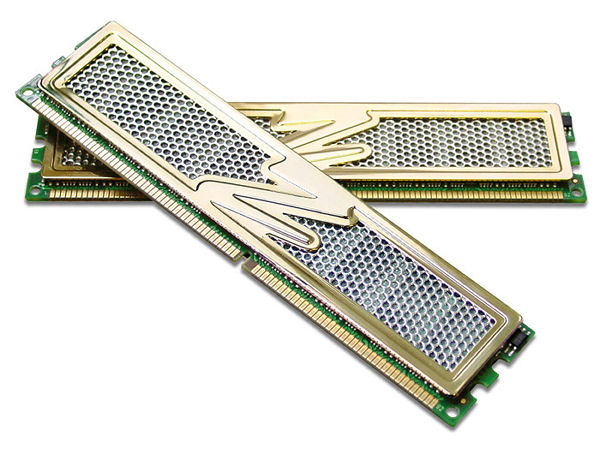Well so much for explanation and speculation! Please join me as we attempt to discern with a high degree of objectivity how well OCZ has meshed NVIDIA’s EPP profile into their Platinum 7200 EPP modules. I assure you we’ll leave no table unturned and after reading this review you should be able to readily determine: 1) If this technology fits your needs and the needs of future patrons of our art; 2) If you’re ready to invest your hard earned $$$ in these memory modules; and 3) If you feel this technology is worthy of being included as one of the many JEDEC standards.
INTRODUCTION
Today we have the a very special opportunity to review some splendid new OCZ DDR-2 memory modules. After this introductory sentence you might be thinking to yourself “just another memory review, what’s so special”? To start with this 2GB pair of DDR-2 sticks is equipped with EPP. What Is EPP, you say? First the official version and then our commentary.
The following is scripted from NVIDIA’s Technical Brief, SLI-Ready Memory with Enhanced Performance Profiles: “System memory modules (DIMMs) are built using an electrically-erasable programmable read-only memory (EEPROM) that can hold up to 256 Bytes of data.” “The EEPROM is used to store Serial Presence Detect (SPD) information defined by JEDEC which include manufacturer part number, manufacturer name, some timing parameters, serial number, etc.” “Only a portion of the EEPROM is defined by the JEDEC SPD specification. Bytes 99 to 256 can be used arbitrarily or left unused by memory manufacturers.”
“EPP technology was defined to utilize the extra space in the EEPROM to store memory configuration settings that are sufficient to optimize and maximize the performance of a memory module. Bytes 99 to 127 are used to store this additional information so that DIMMs with EPP are fully compatible with non-EPP enabled system BIOS.”
When I initially began to read about NVIDIA’s development of Enhanced Performance Profiles I was completely stoked! I saw it as a way for someone totally new to the Computer Enthusiast scene to achieve highly respectable performance out of their system without the hassle of doing it the old fashioned way. We veterans of the art know this can be an extensive, time consuming task that can be frustrating for those that have yet to gain the addiction.
This technology holds quite a bit more potential than just for the newbie! It gives the experienced Computer Enthusiast an established memory overclocking baseline for those who wish to push memory performance to its absolute limit. Most of us that own a current version of any high performance motherboard realize that setting the half-dozen or so memory options that we used to rely upon is now simply a beginning. I personally have seen as many as 20 different memory settings available on some boards and have had to extensively research both their short and long-term benefit to my system’s performance before touching the first setting. Imagine EPP setting all of those functions to a very solid baseline along with a rock solid front sided BUS speed for these optimized settings.
I’m in no way advocating taking all the fun out overclocking, quite the contrary, I’m talking about bypassing the initial arduous and sometimes boring preliminary steps and getting straight to the matter at hand. As systems become more complex this technology can be a real boon to all of the truly hard-core overclockers.
It is my understanding that the Chairman of JEDEC initially rejected the acceptance of this new profile into their series of standards for memory. As we all know standards and such are very often quite political but if this technology is as good as it looks on paper in real life scenarios and a few more companies get on the bandwagon I’m hopeful eventual acceptance will be assured. When companies like Corsair and OCZ adopt this standard for a certain series of their memory modules you can bet that they have done their research and it’s not just hype.
Well so much for explanation and speculation! Please join me as we attempt to discern with a high degree of objectivity how well OCZ has meshed NVIDIA’s EPP profile into their Platinum 7200 EPP modules. I assure you we’ll leave no table unturned and after reading this review you should be able to readily determine: 1) If this technology fits your needs and the needs of future patrons of our art; 2) If you’re ready to invest your hard earned $$$ in these memory modules; and 3) If you feel this technology is worthy of being included as one of the many JEDEC standards.
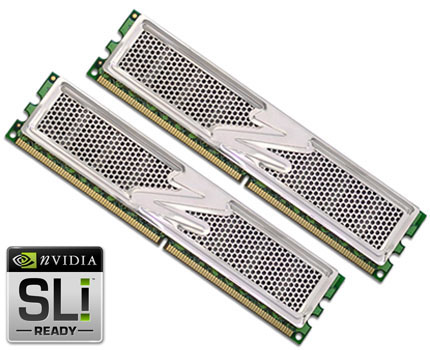
OCZ: A Brief Overview
Entering the memory market in August 2000, OCZ Technology was built around the determination to manufacture the best high speed DDR and RDRAM. OCZ was founded by enthusiasts, for enthusiasts, and our commitment to the end-user has not digressed. OCZ Technology has been an innovator in many areas. We were the first manufacturer to make Dual Channel optimized memory available to the public, which originally took advantage of nVidia’s Twinbank or Dual DDR architecture, found in their nForce chipset. We have now taken that technology and tailored it for the Canterwood, and Granite Bay chipset’s. OCZ developed and was the first to implement ULN technology, which has been a critical element in our manufacturing process for some time. We at OCZ diligently work to improve communication with CPU and motherboard chipset manufacturers prior to the release of their products. Only in this manner can we fine-tune our memory’s SPD settings, ensuring a synergistic relationship between the memory module, memory controller, and microprocessor. In today’s rapidly evolving semiconductor industry, such communication is not simply research, but a necessary component of our manufacturing process.
At OCZ we have one primary goal, and it is to make sure that every customer is 110% satisfied. Every employee at OCZ is dedicated to accomplishing this goal. Our engineers are constantly developing the fastest and best performing products. Our finance department works every angle to bring customers our product at the best price. Our marketing department ensures all the information needed to make an informed purchase is available and presented in an easy to understand format. The technical support department constantly studies and tests the latest hardware to be as informed as possible to help you with any issue you may have. Our customer service department is filled with customer satisfaction fanatics who will refuse to let you be unsatisfied.
A CLOSER LOOK
Roughly six months ago I reviewed OCZ’s Platinum PC 3500 XTC DDR 2 GB kit. For those of you that have read my memory reviews prior to the aforementioned kit you know “I’m usually not one to get excited about the look of memory stick(s) as their functionality is my primary concern.” I was however quite taken with the looks and functionality of OCZ’s design. These sticks utilize essentially the same golden golden color and the proven functional honey combed design of the heatspeaders to make for one visually appealing set of RAM.
Features
- 900MHz DDR2
- EPP 4-4-3-15 (CAS-TRCD-TRP-TRAS)
- Available in 2GB (2×1024) dual channel kits
- Also available in a 1GB modules
- Unbuffered
- Platinum Mirrored XTC Heatspreader*
- Lifetime Warranty
- 2.1 Volts
- 240 Pin DIMM
* XTC (Xtreme Thermal Convection) heatspreaders optimize the thermal management of memory modules by promoting greater airflow by means of micro-convection throughout what is usually the dead air space inside conventional heatspreader designs. In this manner, build-up of heat is avoided and thermal dissipation of the memory components is offloaded more efficiently through the honeycomb design. At the same time, mechanical stability is maintained.
Special Features
- NVIDIA® SLI™ certified
- 2.2V EVP**
**OCZ EVP (Extended Voltage Protection) is a feature that allows performance enthusiasts to use a VDIMM of 2.2V ± 5% without invalidating their OCZ Lifetime Warranty.
OCZ’s Approach to EPP?
OCZ PC2-7200 Platinum Series is equipped with NVIDIA Enhanced Performance Profiles (EPP) to optimize the modules’ performance on nForce® 590 SLI-based motherboards. OCZ exclusively engineered select high-performance modules with advanced SPD (Serial Presence Detect) settings to allow compatible motherboards to recognize and utilize the added information, ultimately increasing the performance potential of the entire platform.
OCZ SLI-Ready memory modules are programmed to boot at 900MHz DDR2 with supremely fast timings of 4-4-3. Only motherboards equipped with the custom-designed BIOS, such as those designed for NVIDIA nForce 590 SLI MCPs, can detect the optimized SPD profiles and ensure the memory functions under the best possible conditions. The exclusive OCZ SPD specifications take out the guesswork and provide enthusiasts and gamers with significant overclocked performance with no manual adjustment or compatibility issues.
Packaging & Contents
The OCZ package although not that secure looking in and of itself arrived draped in triple layered bubble wrap and nestled in about 4-5 inches of Styrofoam “peanut” packing. I sincerely believe the package could have survived almost anything the “shippers of the world” had to throw at it and still functioned flawlessly.
Inside the packed along with the 2 GB (2 x 1 MB) sticks was OCZ’s was a small thin piece of card stock which serves two purposes: 1) To add rigidity to the packing thus helping to support the enclosure; and 2) To provide the consumer with a brief amount of advertising concerning OCZ products. No instructions per se were included, but then again who needs them?
Again my photos don’t do the golden color of this memory justice as depicted in a professional image depicted below. The color is highly reflective and a bit luminescent and has a tendency to change its aura in various lighting conditions. I can envision this memory showcased in a large windowed case that is properly lit with the right colored neon tubes. If my imagination serves me properly it should be quite elegant and stylish. Ok, enough of the flash and fancy and on to what these type of reviews are really all about and that’s PERFORMANCE!
TESTING
Test System
- AMD X2 5000+ running at default speed
- ZALMAN CNPS9500AM2 HSF
- ASUS M2N32-SLI Deluxe nForce 590 motherboard
- Test Memory 1: 2GB of OCZ 7800 DDR-2 EPP SDRAM tested at various timings and voltages
- Test Memory 2: 2GB of Mushkin Redline 8000 DDR-2 non-Epp SDRAM tested at various timings and voltages
- XFX® GeForce™ 7950 GT XT running ForceWare 91.47 drivers
- 2 – Seagate Barracuda ES 750 GB SATA Drives
- Corsair’s CMPSU-620HX 620 watt power supply
- Antec SOLO Case
- Windows XP Pro SP2
- Samsung Syncmaster 213T 21.3″ LCD Monitor
Benchmarks
Synthetic Benchmarks
- SiSoft SANDRA 2007 Professional
- Everest Ultimate Edition v. 3.01
- Super Pi 2 Meg Calculation – Mod 1.5XS
- PCMark 2005
Gaming Benchmarks
- Counter-Strike: Source, Video Stress Test
- F.E.A.R. v 1.07
- Serious Sam II v 2.068
Testing Methodology
The testing methodology used here will be a mix of the old and the new. In lieu of trying to edge our way upward with many different manual settings until we find the “sweet spot” of these memory modules we’ll let EPP do some of the work for us. We’ll also use what I’ll call the “Lead and Follow” technique for memory comparison. In other words we’re showcasing the OCZ Memory in this review and we’ll find various points to highlight with this memory and use those exact same timings and voltages with our Mushkin RAM to see how it compares. While not exactly comparing apples to apples we feel this type of testing protocol is the fairest to both manufacturers. We also must not forget that the Mushkin is DDR-2 8000 meaning it’s rated for 1,000 MHz performance while the OCZ is DDR-2 7200 meaning it’s rated for 900 MHz. This would mean that the Mushkin has allegedly more headroom than the OCZ.
First we decided to find the best latency beginning point of the memory using lowest voltage possible. These settings turned out to be 4-4-3-9 1T at 1.9 volts with a FSB of 200 and the standard chip multiplier of 13 yielding a memory speed of 742 MHz. Next we played around a bit upping the FSB in small increments of 5- 10 MHz at a time while using the standard multiplier. With the AMD AM2 5000+ there’s not a lot of headroom using the standard multiplier, the best I’ve been able to achieve at a reasonably stable state is around 230. Rather than waste a lot of time playing with this multiplier I decided to go ahead and test the EPP function of the memory to find out where it would take me. I chose both “High Performance” and the “Highest OC” to begin with and low and behold the EPP chose the following settings: 4-5-3-15-2T at 2.1 volts. EPP automatically changed the multiplier to 12 and the FSB to 230 yielding a memory speed of 920 MHz, for a second spot of comparison
Finally I knew this chip performed quite well at a multiplier of 10 and felt like I could reach a considerably higher FSB using this setting. The OCZ memory required settings of 5-5-5-15 2T and 2.1 volts, but was perfectly stable at a FSB of 250 yielding a memory speed of 1,000 MHz so this was my next testing spot. I knew the memory had more left in it so I upped it in 5MHz increments until I got to a FSB of 270 using they same timings as at 250 MHz. Upping the VDimm to 2.2 volts made the memory perfectly stable and yielded a speed of 1,080 MHz. This as it turned out was my final point of testing as with my test rig I was unable to get a completely stable system even upping the voltage to 2.3. So we have in a matter of approximately 1.5 hours what I consider to be the four sweet spots to test both the OCZ and Mushkin memory sticks. How did they perform? Read on!
TEST RESULTS
Synthetic Benchmarks

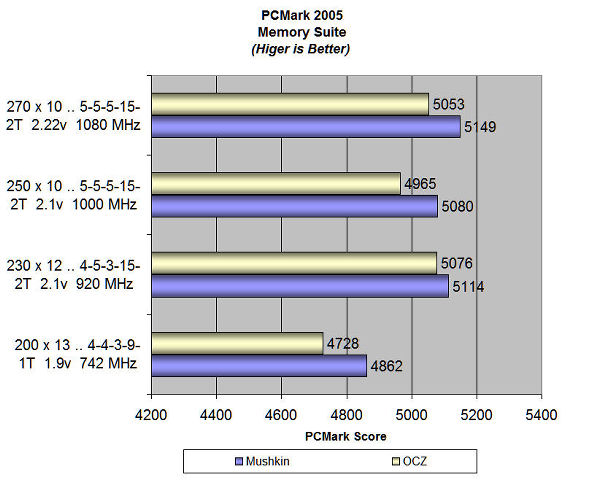
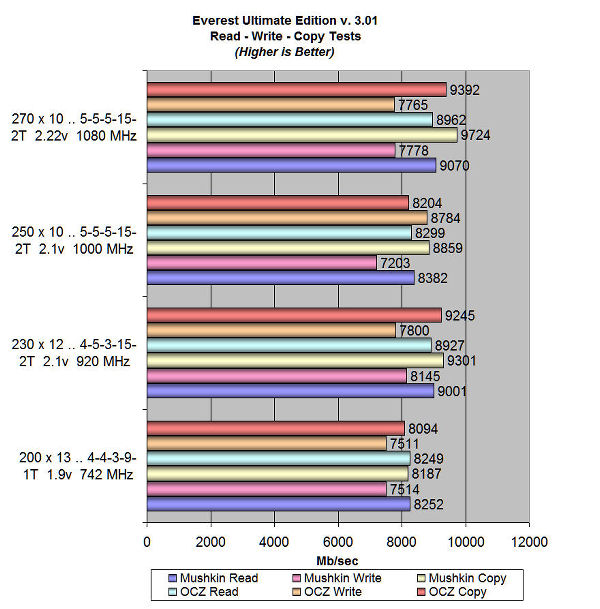
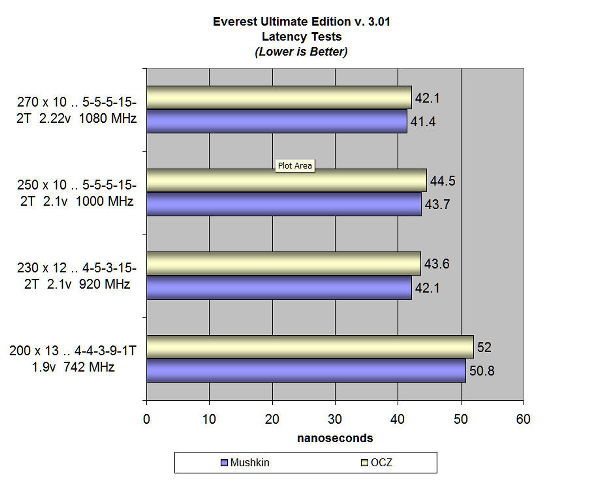

TEST RESULTS cont.
Gaming Benchmarks
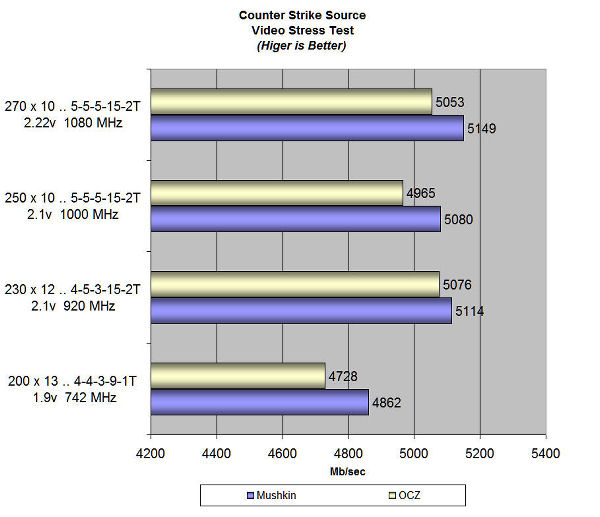

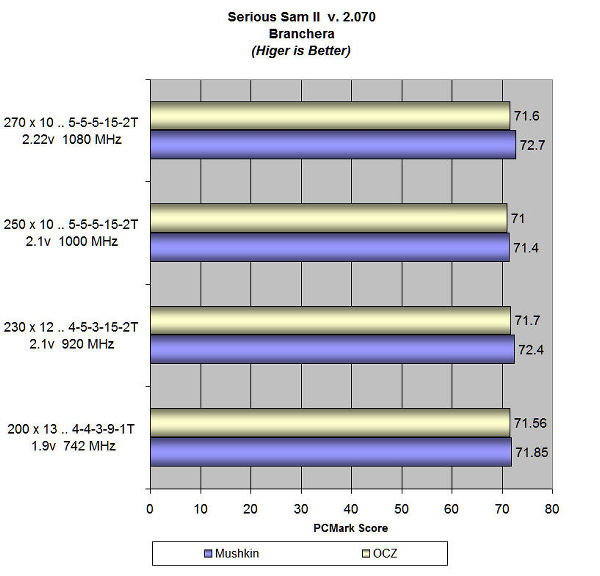
CONCLUSION
As noted in the above captioned benchmarks the OCZ Platinum 7200 performed extremely well besting it’s rated speed of 900 MHz by 20% which I think is quite excellent. The Mushkin as expected was a bit faster due to the additional headroom that its 1000 MHz rating offered. The speed differences between the two was negligible to say the least even though the Mushkin is capable of near 1,200 MHz stable performance which gives it a similar 20% gain over its rated performance. I also believe had I been using a CPU with more overclocking ability at its standard multiplier that we would have even have seen better performance from the OCZ, possibly just over 1,100 MHz. Realize to that the 13 multiplier of the 5000+ mathematically yields a smaller gain than a chip with an even multiplier does.
Now a few more thoughts on EPP that I neglected to mention in the testing area. With EPP you are given several options two of which I mentioned earlier, “High Performance” and “Highest OC”. In addition there are several other parameters you can choose such as “Highest Frequency”. No matter what combinations or single choice of these options I chose the EPP yielded the same results as described above. I’m not saying it’s a “One Trick Pony” but even after resetting the CMOS I was still only given the one option using EPP to choose my settings. Possibly this is due to the fact that this technology is till in its infancy and currently is limited to working with the 590 series of AMD boards although I understand the soon to be released AMD 590 series Intel boards will also support EPP. I believe this technology still is very interesting and should be investigated by Intel as well. There is no telling with a few generations of maturity under its belt what the yield to the Computer Enthusiast and newbie alike might be.
All in all I think OCZ has produced another excellent product that I can highly recommend to anyone looking for high-performance DDR-2 memory. I see no reason why the EPP options included with the Platinum 7200 would in anyway preclude it from working with the Intel Core 2 Duo systems whether the motherboard supports EPP or not. Price Grabber currently shows the best pricing for this memory to be at Zip Zoom Fly for a price of $353.99 USD for the 2 GB matched kit that is identical to the one we tested. I do not find the pricing for this quality of memory to be exorbitant, in fact it’s in line with other high-performance DDR-2 memory that doesn’t have the EPP option.
OCZ is known for producing a superior product and the Platinum 7200 EPP DDR-2 is certainly no exception. We highly recommend it for any system requiring the talents this high-performance RAM has to offer. It will be especially nice if your system happens to support NVIDIA’s new EPP technology which should skyrocket if adopted by all chipset and motherboard manufacturers.
Pros:
+ Stylish yet functional golden honeycombed mesh heat spreaders
+ Performs around 20% better than it’s rated speed
+ Low latencies for DDR-2
+ Supports NVIDIA’s EPP technology
+ Life Time Warranty
+ Very focused and rapid customer service
+ 100% Hand Tested in pairs
Cons:
– NVIDIA’s EPP technology currently appeals to a limited consumer market
– EPP yielded only one option no matter which parameters chosen
Final Score: 8.5 out of 10, and the Bjorn3D Seal of Approval
 Bjorn3D.com Bjorn3d.com – Satisfying Your Daily Tech Cravings Since 1996
Bjorn3D.com Bjorn3d.com – Satisfying Your Daily Tech Cravings Since 1996
